Mhc notes - Study guides, Study notes & Summaries
Looking for the best study guides, study notes and summaries about Mhc notes? On this page you'll find 35 study documents about Mhc notes.
All 35 results
Sort by
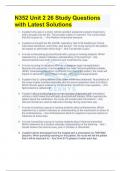
-
N352 Unit 2 Study Questions and Answers with Latest Solutions (2024)
- Exam (elaborations) • 3 pages • 2024
-
- R159,06
- + learn more
N352 Unit 2 Study Questions and Answers with Latest Solutions (2024)A patient who was in a motor vehicle accident sustained a severe head injury and is brought into the ED. The provider orders IV mannitol. The nurse knows that this is given to...A patient is brought the ED w/SOB, respiratory rate of 30 breaths per minute. Intercostal retractions, and frothy, pink sputum. The nurse caring for this patient will expect to administer which drug?A nurse is discussing glucocorticoids with a group of n...
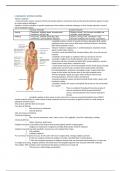
-
LYMPHATIC SYSTEM NOTES
- Exam (elaborations) • 5 pages • 2024
-
- R187,16
- + learn more
LYMPHATIC SYSTEM NOTES -Disease resistance - Innate immunity- passive, present at birth and includes defense mechanisms that provide general protection against invasion by a wide range of pathogens -Adaptive- involves activation of specific lymphocytes that combat a particular pathogen or other foreign substance (carried out by lymphatic system) Passive Immunity Active Immunity Natural Temporary, antibody based, transplacental, colostrum, milk IgG, IgA Lifetime, strong T cell, increase mo...
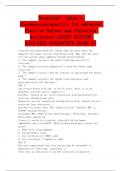
-
Rosenthal: Lehne's Pharmacotherapeutics for Advanced Practice Nurses and Physician Assistants LATEST EDITION 2024/2025 GUARANTEED GRADE A+
- Exam (elaborations) • 87 pages • 2024
-
- R337,04
- + learn more
A patient who breastfeeds her infant asks the nurse about the immunity the infant receives from breast milk. What does the nurse tell the patient about immunity through breastfeeding? a. "The immunity protects the infant from hypersensitivity reactions." b. "The immunity provides phagocytes to help the infant fight infections." c. "The immunity results from the transfer of IgA through the breast milk." d. "The immunity protects the infant from respiratory and gastrointestinal (GI) mic...
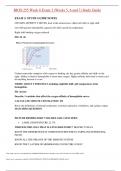
-
BIOS-255 Week 8 Exam 3 (Weeks 5, 6 and 7) Study Guide
- Other • 4 pages • 2024
-
- R252,73
- + learn more
BIOS-255 Week 8 Exam 3 (Weeks 5, 6 and 7) Study Guide EXAM 3: STUDY GUIDE NOTES OXYGEN AFFINITY CURVES: look at the normal curve (blue) left shift or right shift Left shift greater hemoglobin capa city left shift caused by temperature Right shift binding oxygen reduced FIG 22. 26 Carbon monoxide competes with oxygen to binding site has greater affinity and shifts to the right. Ability to bind to hemoglobin is more than oxygen. Higher affinity delivered to tissue can’t do anything because it is...
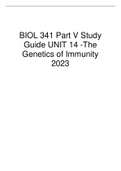
-
BIOL 341 Part V Study Guide UNIT 14 -The Genetics of Immunity 2023
- Exam (elaborations) • 13 pages • 2022
- Available in package deal
-
- R187,16
- + learn more
UNIT 14 The Genetics of Immunity Most human beings survive the effects of constant exposure to pathogenic (disease causing) organisms or viruses, parasites, and environmental insults largely because people are protected by both nonspecific and specific defence mechanisms. Physical defence mechanisms provide critical first-line protection against a variety of dangers, but are of relatively little interest from a genetic standpoint. On the other hand, specific defence mechanisms involve an extre...
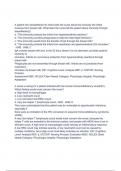
-
Rosenthal: Lehne's Pharmacotherapeutics for Advanced Practice Nurses and Physician Assistants
- Exam (elaborations) • 146 pages • 2024
- Available in package deal
-
- R327,67
- + learn more
Rosenthal: Lehne's Pharmacotherapeutics for Advanced Practice Nurses and Physician Assistants A patient who breastfeeds her infant asks the nurse about the immunity the infant receives from breast milk. What does the nurse tell the patient about immunity through breastfeeding? a. "The immunity protects the infant from hypersensitivity reactions." b. "The immunity provides phagocytes to help the infant fight infections." c. "The immunity results from the transfer of IgA through ...
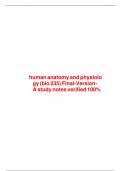
-
human anatomy and physiology (bio 235) Final-Version-A study notes verified 100%
- Other • 13 pages • 2024
-
- R234,00
- + learn more
human anatomy and physiology (bio 235) Final-Version-A study notes verified 100%human anatomy and physiology (bio 235) Final-Version-A study notes verified 100% Final Review Version A Chapter 19: The Cardiovascular System: The Blood • Buffy Coat: The fraction of an anticoagulated blood sample that contains most of the WBCs and platelets. (Page 662) • Plasma Proteins: Proteins confined to blood; include: albumins, globulin, and fibrinogen. (Page 664) • White bl...

-
Immunology Notes - BMI2607
- Class notes • 31 pages • 2022
-
- R87,00
- + learn more
Notes on the major histocompatibility complex, immune system cells, and primary and secondary immunological responses can be found in this document. This PDF contains all of the multiple-choice questions (MCQs), both short and lengthy. Tables, graphs, and key points are used to lay down concepts. Visit us on YouTube @sciencera or join our telegram group at
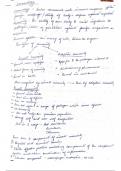
-
Introduction to immunology-immunity, antigens and haptens class notes for first year students
- Class notes • 21 pages • 2024
-
- R290,20
- + learn more
Immunology is the study of the immune system, which protects the body from infections and diseases. It encompasses understanding how the body distinguishes between its own cells and foreign invaders such as bacteria, viruses, and parasites. Key components of the immune system includes innate immunity, acquired immunity, antigen, antibodies, types of cells, immune system, MHC molecule, complement system and haptens. Understanding immunology is crucial for developing vaccines, treating autoimmune...
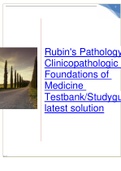
-
Rubin's Pathology: Clinicopathologic Foundations of Medicine Testbank/Studyguide latest solution
- Exam (elaborations) • 232 pages • 2023
-
- R393,24
- + learn more
1 Chapter 1: Cell Adaptation, Injury and Death Ischemia and other toxic injuries increase the accumulation of intracellular calcium as a result 1. of: A) release of stored calcium from the mitochondria. B) improved intracellular volume regulation. C) decreased influx across the cell membrane. D) attraction of calcium to fatty infiltrates. The patient is found to have liver disease, resulting in the removal of a lobe of his liver. 2. Adaptation to the reduced size o...

That summary you just bought made someone very happy. Also get paid weekly? Sell your study documents on Stuvia! Discover all about earning on Stuvia


